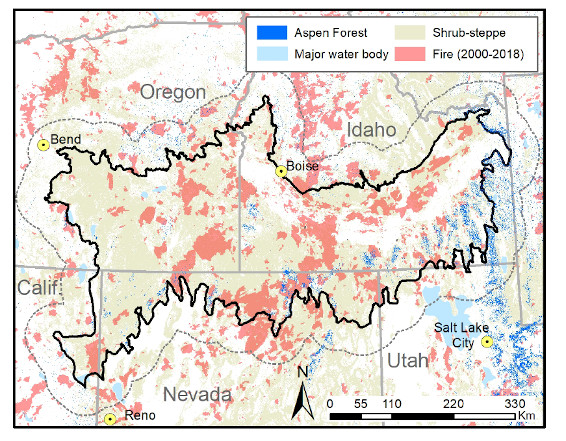A special thanks to Kent State News for featuring our work!
We recently started a new project to investigate the vulnerability of lower-ecotone aspen forests to altered fire regimes and climate dynamics in the northern Great Basin. The project is funded by a recent grant ($299,842) from the Northwest Climate Adaptation Science Center and is intended to deliver actionable science to decision makers. Tim is the lead investigator on the Kent State side of the project and collaborating with Doug Shinneman (overall project lead, US Geological Survey), Susan McIlroy (USGS), Paul Rogers (Utah State University) and Don Major (US Bureau of Land Management). We’ll be recruiting a post-doctoral scientist to assist with this project in the next few months. We’re looking for someone with strong geospatial skills (e.g. R, Google Earth Engine), strong data science skills (making sense of field data using reproducible workflows), and a thorough understanding of disturbance processes in western North America (e.g. fire, drought, aspen regeneration, etc.). Please see the ‘Lab Opportunities’ page for more information or contact Tim. More to come.
Project Lay Summary
Aspen forests provide habitat for numerous plant and animal species and are considered a keystone ecosystem. Aspen also provide important economic and social benefits, including drawing tourists, serve as potential fire breaks, improve local economies, and provide forage for wildlife and livestock. Aspen are considered at risk in many areas of the western United States, from climate-change and past land use. This is especially true for lower-elevation aspen, where the effects of drought and browsing animals (that eat young aspen) are often more severe and can threaten aspen forest health and long-term persistence. In the northern Great Basin, lower-elevation aspen stands often occur as small, isolated patches within sagebrush-dominated landscapes. Sagebrush shrublands are increasingly being transformed into grasslands that are composed of exotic, fire-prone plant species not native to North America. Although aspen is a fire-adapted species, if fire is too frequent at low elevations it could negatively affect aspen survival, especially when combined with impacts from exotic plants, worsening droughts, or other stresses, such as insects and disease. The intent of this research is to investigate how these changing disturbance and climate conditions (e.g., drought) are affecting lower-elevation aspen forests in the northern Great Basin. To accomplish this, we will use a combination of field sampling, geographic analysis, remote sensing, and statistical modeling. The primary outcomes will be a regional assessment of where and under what conditions lower-elevation aspen are most vulnerable to undesirable ecological change (i.e., potential decline in forest health). The tools and information from this research will have direct and timely uses for land managers working to conserve aspen forests in the Great Basin and surrounding regions.

Top image: The vulnerable aspen-sagebrush ecotone, northwest Colorado.
